Ronald H. Cox: Veteran of the Month | August 2024
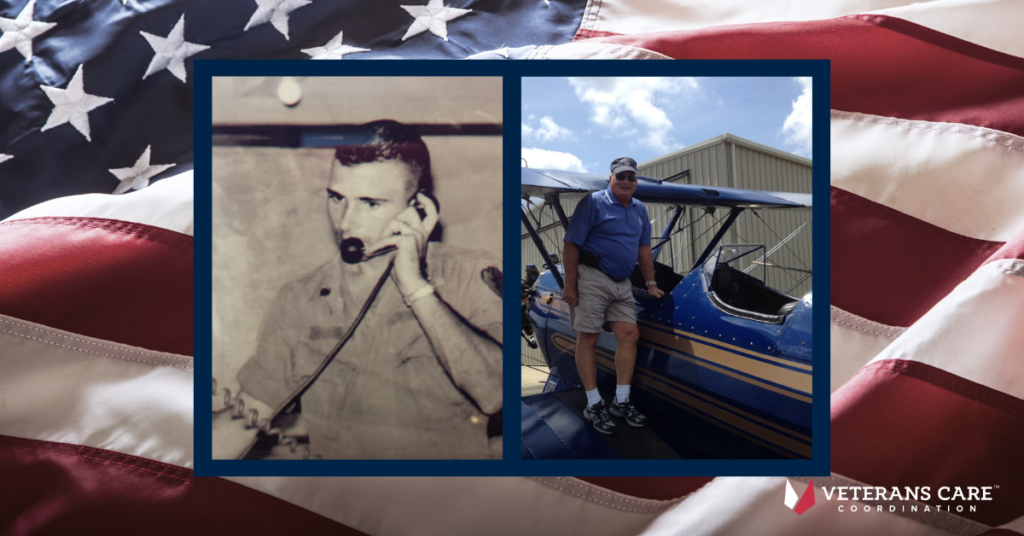
On the right, Cox is standing on a Stearman biplane he enjoyed flying with minimal instruments.
Ronald H. Cox was born in January 1943 and raised in a middle-class family in the Saint Louis area. As the oldest of three children, Cox experienced a typical middle-class upbringing. He fondly recalls growing up with fun memories of boating, family vacations, and participating in activities typical of middle-class families. Due to his mother’s difficulties with pregnancies, there was a seven-year age gap between him and his brother and a sixteen-year gap between him and his youngest sibling, Diane.
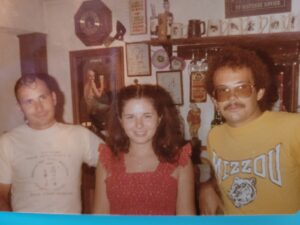
From left Ron Cox, Diane Gambill, and their brother Jerry Cox, 1975.
Cox graduated from Christian Brothers College High School before starting college at St. Louis University, where he was a history and psychology major. Four weeks after graduating college in 1965, he was sitting in a job interview when they asked about his current draft status. Cox wasn’t exactly sure since he tried to test into the Marines during his junior year of college but was denied due to a stigmatism in his eye. He contacted his local draft board, who told him he didn’t need to bother with any more interviews because he would be drafted into the military. Cox discovered that since he graduated from an approved college, he would be guaranteed entry into the Officer Candidate School (OCS) but would need to attend basic and advanced individual training (AIT) first. Cox recalled with a laugh, “Here I am four weeks before taking courses in English Literature, and the next thing I know, I am in Fort Gordon, Georgia, it’s four o’clock in the morning, and some master sergeant is coming in yelling profanities to get us out of bed, and I am thinking to myself that it was a real smart move getting into this military stuff.”
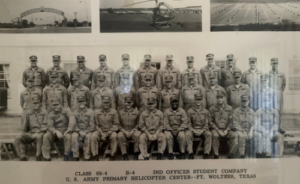
Cox, front row center with his flight school class.
After completing basic training and AIT at Fort Gordon and OCS at Fort Benning, GA, in 1966, Cox was sent to Fort Leonardwood, MO, as a training officer in an infantry company for four months. By the fall, he received his orders to go to Vietnam, but before heading straight to Vietnam, he was sent to Panama for a Jungle Operations Training Course in the Panama Canal. Jungle school is an intense training course through rugged terrain similar to what they would encounter in Vietnam and helped transition the men to learn how to live and survive in the jungle. Cox stated, “They ran about 200 people through class, and all of us were going to Vietnam that went through the course. It was all about getting us used to the jungle climate, and the jungles of Panama were as bad as the jungles of Vietnam.”
Once he completed eleven consecutive months of training, Cox was granted thirty days of leave to visit his family before being deployed to Vietnam. He was assigned to the 3rd battalion, 22nd Infantry in Dau Tieng, where he held three different positions in the span of one year: mortar platoon leader, recon platoon leader, and company XO. A company XO is an executive officer who serves as the second-in-command to the company commander. Cox explained how they would be in the jungle for three to four weeks at a time with a platoon on a recon mission. During one mission, they were involved in what he called a “short round,” a military phrase that refers to a dangerous situation where artillery rounds meant to hit the enemy fall short and land too close to the soldiers who called in for the artillery. Cox recalled, “I was sitting on an anthill with my elbow resting on my kneecap, and this round pushed shrapnel through my arm and along my side, and I was medivaced out to the hospital.”
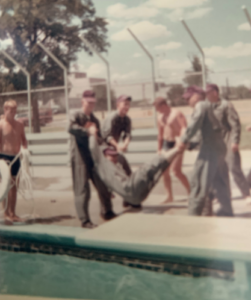
Cox being tossed into the pool as his initiation for completing his first solo flight in July 1968.
After spending two days in the hospital, he was sent back to Dau Tieng with bandages from his wrist to his elbow and down his side. While he was recovering, he visited his uncle, who was working for a company that worked with the utilities in country. When he returned from his visit, he was not quite ready to go out into the field after his injuries when he got a call to help run supplies to his battalion, which was under heavy attack from the Viet Cong (VC). “We got a call at 4 o’clock in the morning that the battalion was getting overrun by the VC, and they were under heavy, heavy attack,” Cox explained. He revealed that if you had ever seen the movie “Platoon,” the final scene is based on the battle he was referring to, emphasizing, “Most of those scenes about the battle had a lot of truth in them. What he wrote was real. That movie was as close to being in combat as you could possibly be. ” Cox choked up when he recalled what he saw that morning and said, “It was a scene that I will never forget.”
Cox was next transferred to Delta Company as their XO and eventually returned home to the United States. Upon his return, he decided to continue serving in the Army. He said, “I became a regular Army officer, but I always wanted to fly, so I became a helicopter pilot.” In 1968, Cox went to Fort Walters, Texas, to train as a pilot, recalling, “This was the good part of the Army; this was a lot of fun.” he completed advanced helicopter training at Hunter Army Air Field in Savannah, GA where he earned all of his qualifications which overall took nine months to complete.
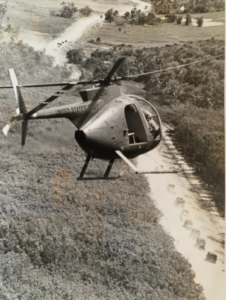
Cox flying convoy cover near the Cambodian boarder.
Once flight school was complete, Cox was deployed back to Vietnam for his second tour, explaining, “I went right back to the same infantry unit, 3rd brigade of the 25th division, and I became the aviation officer.” He flew battalion commanders, Operations Officers, and forward observers for the artillery while also performing reconnaissance missions and various other duties up by the Cambodian border. Cox piloted the OH-6, a light observation helicopter (LOH) known for its maneuverability and turbine power, enabling it to perform missions that larger, slower helicopters could not. He also flew the Huey.
One morning, he was up early to perform a road reconnaissance mission looking for mines that the VC would bury in the road when he had a heart-stopping moment. Cox described, “I’m whipping along doing 60 knots about six or eight feet off the ground, and all the sudden, Kaboom!” Cox immediately pulled up, thinking he was hit when he soon discovered a bird had penetrated the plexiglass of the lower chin bubble. Cox ended up flying 1100 hours of combat time over the course of a year during his second tour in Vietnam. He would typically fly a standard 8-hour day, but during the Cambodian Invasion in 1970, he flew 24 hours in a two-day period, stating, “Once we took off in the morning, we never got out of those helicopters while we were there.”
Two weeks before Cox was to complete his second tour in Vietnam, he found himself in a potentially dangerous situation. Due to the limited gauges in the OH-6,

Cox flying convoy cover for an M113 approximately 50-100 ft in the air out ahead looking out for VC.
there was a rule that there had to be two pilots on board at nighttime to prevent vertigo. One evening, Cox received a call for a replacement in an area under heavy contact. Cox recalled, “I look around and there is nobody but me and a guy from St. Louis; a 19 year old warrent officer named Morgan.” Cox instructed the young officer to gather his belongings as they were heading to relieve someone at a station in Cambodia. He emphasized, “I told him to bring some extra magazines with him, and I wasn’t talking about the kind you read.” Upon arrival, they picked up the battalion commander. Cox, as the sole pilot on board, flew for about an hour despite the dark and rainy conditions before receiving instructions to drop off the commander and return to base. Facing challenging thunderstorms and unfavorable flying conditions that had developed between them and the base, Cox contacted a Captain he knew at a special forces camp located 25 miles north. He called to find out their activity level and discovered that although they weren’t currently getting hit by VC, the base was activated to blow if anyone approached. The only safe place to land was the helicopter pad, but they wouldn’t be able to leave it all night. Cox, knowing he had no other choice, landed on the pad, which had a trench around it. The young warrant officer, Morgan, asked what they were supposed to do all night out there. Cox said, “You’re gonna take that M16, and you are going to get in one end of this culvert, and I am going to look out the other end, and we are going to pray that the VC doesn’t attack tonight because we are out here all by ourselves.” Luckily, they made it through the night without incident and were able to fly back to base safely in the morning.
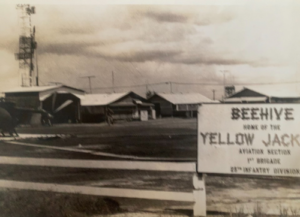
The base where Cox was the Unit Commander, and the reason he was called “Yellow Jacket 6.”
Upon returning to the United States, Cox applied for a regular Army commission and was sent to Fort Benning in Georgia for the nine-month Infantry Advanced Course. At the end of the course, Cox decided to apply for a commercial aviation license through the Army’s program, but when his orders came down, it said “Ranger.” When he inquired about it, he discovered they were sending him to Ranger School. After already completing two tours in Vietnam, once as an infantry officer and once as an aviation officer, he found out that to complete his commission, he was required to go through Ranger or Airborne School. Cox decided he wanted to do both and started with Airborne School, a course that teaches soldiers how to parachute and land safely for military operations open to all military branches. Cox graduated but it wasn’t without incident after having a close call with a parachute that wouldn’t open on a jump. Cox laughed, saying, “I am used to flying these things, not jumping out of them.”
By July of that year, he was reported to Ranger School as a Captain, with two tours under his belt, to learn combat arms-related skills. When he arrived, they handed in a razor blade and told him, “Captain, we want you to cut off your rank on your uniform.” Right then, he became Ranger Cox for the next eight weeks and then became the class commander. Cox shared with a laugh, “I thought Ranger School was the one school that the Army wouldn’t mind killing me; they pushed you.”
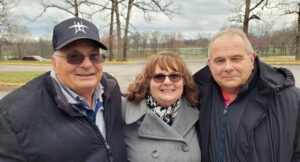
Ron Cox with his siblings in 2022.
Once he completed Ranger school, he was transferred to Fort Riley for two and a half years, where he served as a company commander and an S3, which stands for Operations and Training Officer. From Kansas, he went to Fort Bragg, NC, to attend the Advanced Foreign Area Officers Course. This program trains advanced degree holders to become regional experts with a strategic focus. After completing the course, he was assigned to an ROTC position at Fordham University before the Army sent him to graduate school for international relations. Attending school during the 1970s, a tumultuous time for military personnel, Cox never let anyone know throughout graduate school that he was active military. It wasn’t until the last day of school that he wore his uniform. By the next semester, he took his young professor to Fort Bragg for summer camp and showed him the special forces camp to give him an inside look at how the military functioned. Cox explained, “We became very good friends, and he was impressed. He said he had never seen anything like that or knew how the military worked.” Cox explained that what you see on the news is different from how things work, and there is a lot of misinformation.
Now, with another degree under his belt, he was stationed at Fort Lewis in Washington. Cox really enjoyed being stationed there because of the beautiful mountains on one side and the ocean on the other. At this point, he had advanced to the rank of major and was working as a helicopter company commander and the S3 of the helicopter battalion. He also spent some time on the 9th Infantry (IN) division staff before being chosen to attend the Armed Forces Staff College in Norfolk, VA, for an eight-month program.
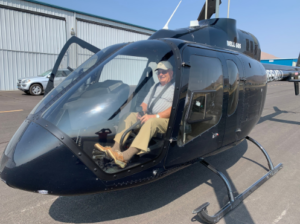
Cox sitting in a Bell 505 helicopter.
After finishing school in Virginia, he needed to transport his vehicles to St. Louis because he was being stationed in Saudi Arabia next. He asked his sister, Diane, to help him drive his car back while he rode his motorcycle. The only problem was that she had never driven a stick shift before. Cox’s sister, Diane recalls, “I got in the car and said, ‘Houston, we have a problem,’ and my brother’s detailed response was, ‘There’s the gas, there’s the break, there’s the clutch, follow me!’ and after 900 miles, I mastered a stick shift. Thanks, Ron!”
Cox arrived in Khamis Mushait in 1980 as the American advisor to the Saudi Arabian Infantry School in southwest Saudi Arabia. When Cox arrived, he said he felt like he was in heaven. They would scuba dive, catch grouper and lobster, and have a fish fry every Friday. Cox recalled, “It was really just a great tour, and I got a lot of experience out there.” This is also where he met his current wife, Brigid, who was from Northern Ireland and worked for the Whittaker Corporation. She was a nurse for the Ministry of Defense and Aviation, which provided medical care to members of the armed forces.
During his last posting at Patrick Air Force Base in Florida, Cox purchased and renovated a house with assistance from his brother-in-law. He lived there until retiring from the military in 1985. After that, he worked with his siblings in a family business for a few years. Later, while in Atlanta, he saw a job advertisement for a flight instructor position at Piper Aircraft. Cox worked there for two and a half years until the company closed in 1990. After that, he worked for a simulator company. By 1991, he established his own company, Aviation Training Management Inc., which he managed for ten years. Cox had instructors operating nationwide until he sold it in 2007 to a retired Marine Corps Major who was also a pilot. He continued to work for him for a few years until he started his own business again. He has been running his own business ever since until he was diagnosed with colon cancer in January of this year. He is currently undergoing chemotherapy and has four treatments left. He has quit flying for now due to the stress of the disease and the chemo treatments, along with a weakened immune system.
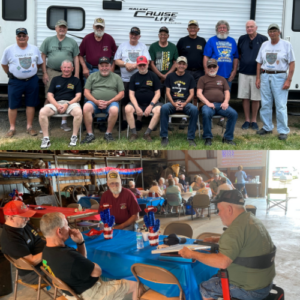
54 years later, Cox reunited with the Vietnam Veterans he served with.
Cox is a proud parent to three lovely daughters. Rhonda and Renee are from his first marriage, and his youngest daughter, Rachel, is from his second marriage. He is also a grandfather to four grandsons, and one of them wants to become a pilot.
Over his distinguished 20-year career, Cox received numerous awards for his dedication and commitment to his country. In reflection, he said, “That’s my life in a capsule, and I wouldn’t change a thing. I would do it all again in a heartbeat.”
Veterans Care Coordination is proud to recognize Ron Cox for his service to our country. We are privileged to have the opportunity to share the stories of our nation’s heroes. Thank you for your service, Ron, and welcome home.
